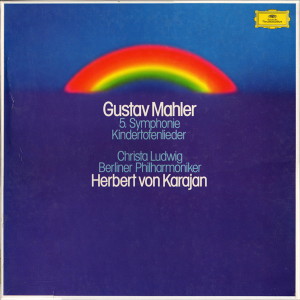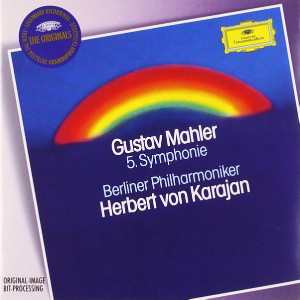 |
|
2 LP's
- 2707 081 - (c) 1975
|
 |
| 1 CD -
447 450-2 - (c) 1996 |
|
| GUSTAV
MAHLER (1860-1911) |
|
|
|
|
|
|
|
| Long Playing 1 |
|
45' 54" |
|
| Symphonie Nr. 5
cis-moll |
|
73' 01" |
|
| - 1. Trauermarsch.
In gemessenem Schritt. Streng. Wie
ein Kondukt |
12' 56" |
|
|
| - 2. Sturmisch
bewegt. Mit grösster Vehemenz |
15' 00" |
|
|
| -
3. Scherzo. Kräftig, nicht zu
schnell |
17' 58" |
|
|
| Long Playing 2 |
|
53' 00" |
|
| -
4. Adagietto. Sehr langsam -
attacca: |
11' 51" |
|
|
| -
5. Rondo-Finale. Allegro - Allegro
giocoso - Frisch |
15' 16" |
|
|
| Kindertotenlieder |
|
25' 53" |
|
| -
1. Nun will die Sonn' so hell
aufgeh'n |
6' 10" |
|
|
| -
2. Nun seh' ich wohl, warum so
dunkle Flammen |
5' 41" |
|
|
| -
3. Wenn, dein Mütterlein |
5' 04" |
|
|
| -
4. Oft denk' ich, sie sind nur
ausgehangen |
3' 24" |
|
|
| -
5. In diesem Wetter, in diesem Braus |
5' 34" |
|
|
|
|
|
|
Christa Ludwig,
Alt (Kindertotenlieder)
|
|
| Berliner
Philharmoniker |
|
| Herbert von
KARAJAN |
|
|
|
|
|
Luogo
e data di registrazione |
|
Jesus-Christus-Kirche,
Berlin (Germania) - 13-16 febbraio
1973 (5. Symphonie)
Philharmonie, Berlin (Germania) -
maggio 1974 (Kindertotenlieder) |
|
|
Registrazione:
live / studio |
|
studio |
|
|
Executive
Producer |
|
Dr.
Hans Hirsch |
|
|
Recording
Producer |
|
Hans Weber |
|
|
Tonmeister
(Balance Engineer) |
|
Günter
Hermanns |
|
|
Prima Edizione
LP |
|
Deutsche
Grammophon | 2707 081 | (2 LP's)
| durata 45' 54" - 53' 00" | (p)
1973 (Symphony) & (p) 1975
(Kindertotenlieder) - (c) 1975 |
Analogico |
|
|
Edizione CD |
|
Deutsche
Grammophon "The Originals" | 447
450-2 | (1 CD) | durata 73' 45" |
(c) 1996 | ADD | (5. Symphonie)
|
|
|
Note |
|
Cover-Design:
Holger Matthies, Hamburg |
|
|
|
|
For all
Mahler’s initial despair
of his new symphony it is
one of his richest
creations. Its broad
tripartite structure -
two-part funeral march,
scherzo, adagietto and
finale - embraces and
reconciles opposing worlds
of grief and frenzy,
longing and joy: worlds
buttressed and joined by
the mellower Arcadian
moods of the work’s middle
movement. To find a work
of art so powerfully
divided against itself and
yet so harmonious we must
turn to Shakespeare, no
less, and the miracle of A
Winter’s Tale.
Mahler began work on the
symphony in his holiday
retreat at Maiernigg in
the Summer of 1901. They
were fruitful times for
him. In November 1901 he
met Alma Schindler whom he
married the following
March. It was a marriage
made perfect in the
symphony which held for
Alma not only ‘the
relation of adult man to
everything that lives’ but
also the very spirit of
Mahler himself. Yet
understandable as Alma’s
feelings were, the Fifth
Symphony is arguably the
first of Mahler’s
symphonies to achieve a
measure of that impersonality
which all great art
aspires to. Not that the
work is less Mahlerisch
than anything that has
gone before. All things
remain grist to the mill
of his imagination. The
fantasy, the painting from
nature, the frenzy and the
tragic preoccupations,
which we find in Das
klagende Lied and
the first four symphonies,
remain strongly in focus
as part of the evolving
drama. Kurt Blaukopf has
compared Mahler’s
symphonic output to
Balzac‘s Comédie
humaine; perhaps a
closer analogy would be
the Roman-fleuve
in the Proust style:
material dream-like and
realistic by turns,
elusive and
psychologically complex,
luminously ordered and
absorbed in a continuously
unfolding pattern.
The Fifth Symphony marks
the beginning of a new and
purer phase in Mahler’s
orchestral writing.
Textures are less solid,
less pianistic; there is a
new economy of detail
(here and in the first
three Kindertotenlieder
which date from the same
period) brought about by
Mahler’s new preoccupation
with instrumental timbre
and polyphonic texturing.
We have only to listen to
the jubilantly ordered
finale of the symphony, or
(in tragic vein) to the
opening movements of both
symphony and Kindertotenlieder,
where a single oboe phrase
can point a world of
sorrow, to recognise the
nature of the miracle
Mahler was working.
Symphonically the work is
more closely argued than
anything Mahler had
hitherto achieved. It is a
remarkable fibrous growth,
so lucid and, in practice,
so complex that analysis
founders in front of it.
The work begins with an
eerie summons: a trumpet
call in C sharp minor (the
same sound we hear at the
tragic disintegration of
the Fourth Symphony’s
first movement) full of
foreboding. In effect, the
first movement is a muted
funeral lament (in C sharp
minor and later in A
minor) juxtaposed with
outbursts which are full
of Faustian yearning. The
end of the movement, rich
in strange sea changes, is
barely an ending. The
music breaks vehemently
out, destructive energy
now in the ascendent, at
the start of the second
phase of the drama.
Already Mahler has
established the leap of a
minor ninth in the music
(in the Faustian outburst
and in the A minor
threnody of the first
movement); now we hear it
as a panic cry on high
woodwlnds. And moments
later, as the strings
strive onwards, locked
within the compass of a
rising semitone, the horns
take up the idea too.
Later in the movement it
recurs, jaunty and
desperate on woodwinds,
and in the abortive
trumpet-led climax moments
afterwards. The D major
chorale, the symphony’s
“crossbeam”, which rises
like Proteus from the
waves, almost lays its
troubled spirit; but the
nightmare returns. The end
of the movement is full of
eerie sounds, the wailing
ninth well to the fore. A
single, solemn pianissimo
drum tap ends the agony.
And then the mood is
marvellously transformed.
The scherzo, with its horn
obbligato and steady
lilting tread is free of
terror. In the trio the
horn calls evoke the
splendour of a romantic
past; after that the waltz
returns, more libidinous
than ever. As Neville
Cardus once remarked
“Mahler didn’t ‘murder’
the Ländler; he ravished
it and got it with child”.
The Adagietto, the prelude
to the joyful finale, is a
richly sung meditation for
strings and harp. “I have
died to the world’s
frenzy,” says the Rückert
poem to which the music
alludes. “I live alone in
my Heaven / In my love, in
my song”.
The ecstatic switch from F
major to G flat major
midway through the
movement is interesting;
again the rising figure
seems to look back,
through the horn call that
launches the scherzo, to
the all-pervasive leaping
ninth. But the music also
looks forward, bearing
riches which the finale
will all too joyfully
seize and transform.
The finale is as joyous as
the finale of Beethoven’s
Eroica Symphony.
The horns blow an A (now
the dominant of D rather
than the mediant of F
major), the bassoon quotes
a phrase from Mahler’s
song “In Praise of Higher
Understanding”
and in one effortless
glide the Allegro
giocoso is launched.
In it the “higher
understanding”,
elements of fugue and
counterpoint, are used in
tumbling profusion, free
of academic inhibition.
(In the song the donkey
awards the singing prize
to the cuckoo, not the
nightingale, thus
compromising his critical
reputation!) The mood is
rich, extrovert and
genial. Towards the end
darkness does briefly
threaten, but the music
moves on its way again,
the woodwinds gambolling
and the strings caressive,
with a vibrance and a
sonority that Mahler never
surpassed. The crossbeam
returns (no religious
chorale, more a gesture of
supreme fulfilment) and
the symphony ends in a
blaze ot wonderment - a
true Song ot the Earth.
The Kindertotenlieder,
Songs on the Death of
Children, begun in 1901
and completed in 1904,
were first heard in Vienna
in January 1905 with the
baritone Friedrich
Weidemann as soloist. The
songs outraged Alma
Mahler. "Rückert did not
write these harrowing
elegies solely out of his
imagination ... For
heaven`s sake don’t tempt
Providence!" But
Providence was tempted.
Within three years Mahler
had lost his eldest
daughter, adding one more
grief to a life already
horrific with personal
loss. Yet these plaintive,
lamenting songs embody
grief; they do not
luxuriate in it. As in the
Fifth Symphony, which they
movingly complement, there
is here a masterful
economy in the writing of
vocal and instrumental
lines and in the
deployment of orchestral
colour. Indeed, not since
Wagner’s Tristan und
Isolde had music of
such poignancy and rare
expressive intensity been
written for voice and
orchestra.
© 1975
Richard Osborne
|
|